Abu Simbel, a colossal monument nestled in the heart of southern Egypt, captivates the imagination with its breathtaking architecture and rich historical significance. Carved into the sheer rock face during the reign of Ramses II, this iconic temple complex stands as a testament to the ingenuity and artistry of ancient Egyptian civilization.
Its grand facade, adorned with colossal statues of Ramses II, beckons visitors to delve into a realm of grandeur and intrigue. Within its hallowed halls, intricate reliefs depict scenes of triumph and devotion, offering a glimpse into the life and times of one of Egypt’s most renowned pharaohs.
Historical Significance

The construction of Abu Simbel was commissioned by the great Pharaoh Ramesses II during the 13th century BCE, as a monument to his victory in the Battle of Kadesh against the Hittites.
Abu Simbel holds immense historical significance as a testament to the architectural prowess and artistic achievements of ancient Egyptian civilization. It is one of the most iconic and well-preserved monuments from that era, showcasing the grandeur and sophistication of ancient Egyptian culture.
The magnificent Abu Simbel temples are a must-see for families seeking a blend of history and adventure. These colossal structures, carved into the sandstone cliffs, offer a glimpse into ancient Egypt’s grandeur. After exploring Abu Simbel, consider planning a stay at one of the many family-friendly resorts nearby.
These resorts provide comfortable accommodations, kid-friendly activities, and convenient access to the temples. Return to Abu Simbel for a sunset visit, where the golden rays illuminate the temples in a breathtaking spectacle.
Importance for Ramesses II
For Ramesses II, Abu Simbel was a symbol of his power and legacy. The temple was designed to intimidate enemies and demonstrate the might of his reign. The colossal statues of Ramesses II that adorn the temple’s facade are a testament to his self-aggrandizement and his desire to be remembered as one of Egypt’s greatest rulers.
Religious Significance
In addition to its political significance, Abu Simbel also held religious importance. The temple was dedicated to the gods Amun-Ra, Ra-Horakhty, and Ptah, and was used for religious ceremonies and rituals. The temple’s orientation was carefully planned to align with the rising sun on the pharaoh’s birthday and the anniversary of his coronation, further emphasizing the connection between Ramesses II and the divine.
Architectural Design: Abu Simbel
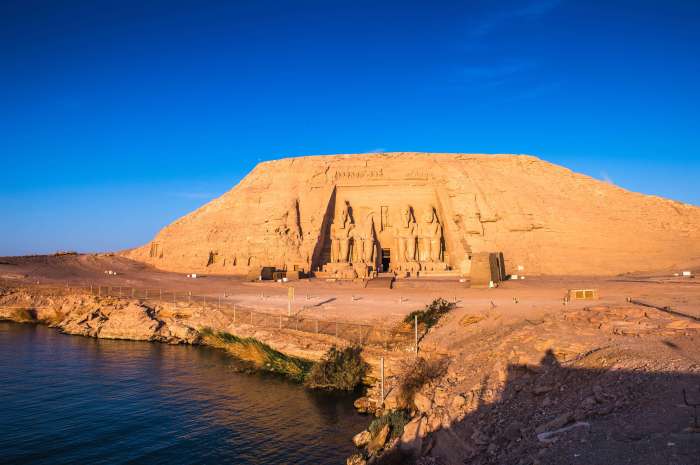
Abu Simbel stands as a testament to the architectural brilliance of ancient Egypt. Its unique design and construction techniques showcase the ingenuity and precision of its creators.
The temples are carved directly into the sandstone cliffs, creating a harmonious blend of architecture and nature. The massive facade features four colossal statues of Ramses II, each standing over 20 meters tall. These statues represent the pharaoh in various poses, symbolizing his power and divinity.
Construction Techniques
The construction of Abu Simbel was a remarkable feat of engineering. The builders used copper chisels and hammers to carve the statues and temple walls out of the solid rock. The precise measurements and intricate details demonstrate the skill and craftsmanship of the ancient Egyptians.
To protect the temple from the elements, the facade was covered with a layer of plaster and painted with vibrant colors. The interior walls were adorned with reliefs depicting scenes from Ramses II’s military campaigns and religious ceremonies.
Sculptures and Reliefs
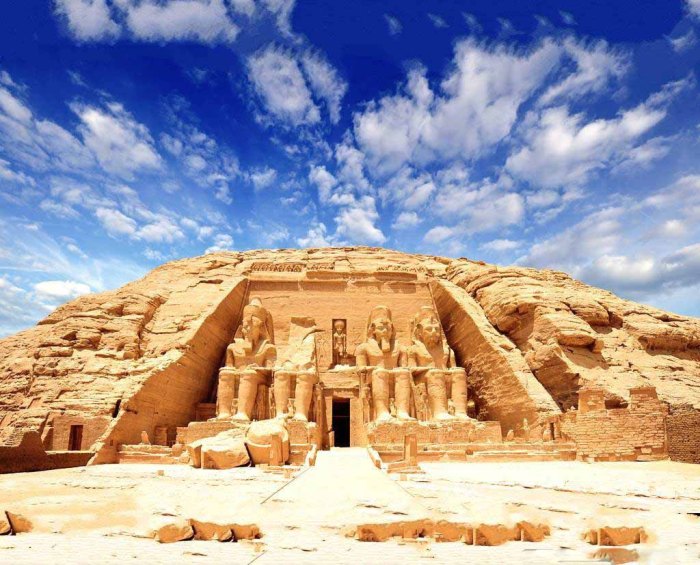
The Abu Simbel temples are adorned with colossal statues and intricate reliefs that serve as a testament to the power and grandeur of Ramses II.
Colossal Statues of Ramses II
Four colossal statues of Ramses II flank the entrance to the Great Temple. Each statue is approximately 20 meters tall and depicts the pharaoh seated on his throne, wearing the double crown of Upper and Lower Egypt. The statues symbolize Ramses II’s divine authority and his role as a protector of Egypt.
The faces of the statues are serene and majestic, conveying a sense of power and confidence. The bodies are muscular and athletic, emphasizing Ramses II’s physical prowess. The statues are carved from a single block of sandstone, demonstrating the incredible skill and precision of the ancient Egyptian craftsmen.
Reliefs Depicting Scenes from Ramses II’s Reign
The interior walls of the temples are covered in intricate reliefs depicting scenes from Ramses II’s reign. These reliefs provide a visual narrative of the pharaoh’s military victories, his building projects, and his religious rituals.
One of the most famous reliefs depicts the Battle of Kadesh, one of Ramses II’s most significant military campaigns. The relief shows Ramses II charging into battle on his chariot, leading his troops to victory. The relief is highly detailed and provides a vivid account of the battle.
Other reliefs depict Ramses II making offerings to the gods, building temples and palaces, and hunting. These reliefs offer a glimpse into the life and times of one of Egypt’s most powerful pharaohs.
Preservation and Restoration
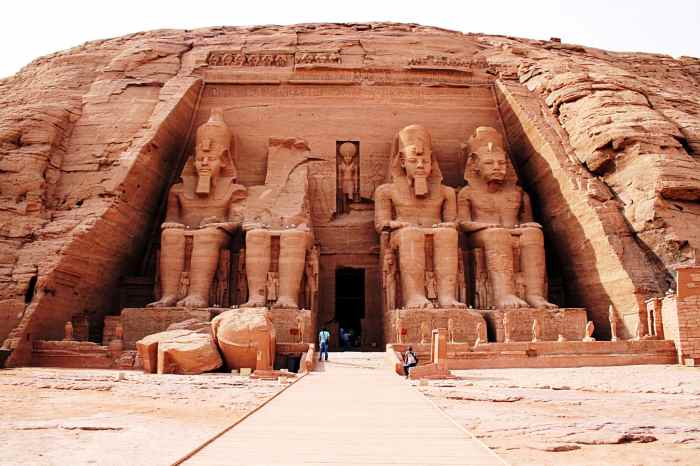
Abu Simbel has faced significant challenges in terms of preservation and restoration due to erosion and natural disasters. The temple’s sandstone exterior has been susceptible to weathering and wind erosion, which have caused damage to the sculptures and reliefs. Additionally, the temple has been subjected to flooding and earthquakes, which have further compromised its structural integrity.
Relocation Efforts
To protect Abu Simbel from these threats, a major relocation effort was undertaken in the 1960s. The temple was carefully dismantled and moved to a higher location, approximately 200 meters away from its original site. The relocation process involved cutting the temple into large blocks and transporting them to the new site, where they were reassembled.
The relocation effort was a complex and challenging undertaking, but it was ultimately successful in preserving Abu Simbel from further damage. The temple’s new location provides better protection from erosion and flooding, and it is now considered to be one of the most important archaeological sites in the world.
Tourism and Cultural Impact
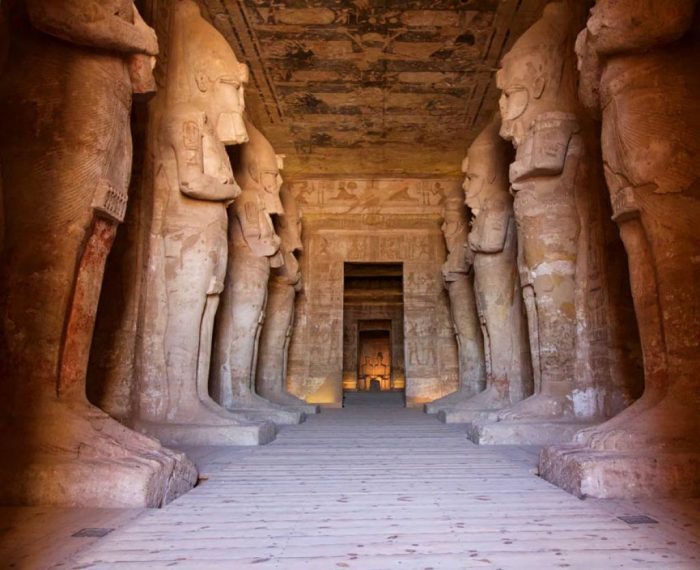
Abu Simbel holds immense significance as a tourist destination, attracting visitors from around the globe. Its breathtaking temples and captivating history have made it a UNESCO World Heritage Site.
The influx of tourism has brought substantial economic benefits to the region. The establishment of hotels, restaurants, and souvenir shops has created employment opportunities and boosted local businesses. Moreover, the preservation and restoration efforts have contributed to the preservation of this ancient marvel, ensuring its legacy for future generations.
Cultural Significance, Abu simbel
Beyond its economic impact, Abu Simbel has a profound cultural significance. The temples embody the grandeur and artistry of ancient Egypt, showcasing the ingenuity and craftsmanship of the pharaohs. The intricate reliefs and sculptures depict scenes from Egyptian mythology, history, and daily life, providing invaluable insights into the beliefs and values of the time.
The awe-inspiring Abu Simbel temples, carved into a mountainside, stand as a testament to ancient Egypt’s architectural prowess. While they may not be known for scuba diving, the region offers access to the Red Sea, renowned for its vibrant coral reefs and diverse marine life.
Discover the underwater wonders of Egypt by exploring the numerous scuba diving locations along the coast, and return to marvel at the colossal statues of Abu Simbel, where history and nature intertwine.
The temples have also become symbols of cultural identity and pride for the Egyptian people. Their relocation from the rising waters of Lake Nasser during the Aswan High Dam project was a testament to the nation’s determination to preserve its heritage. Abu Simbel stands as a reminder of Egypt’s rich past and continues to inspire awe and admiration among visitors today.
Historical and Cultural Comparisons
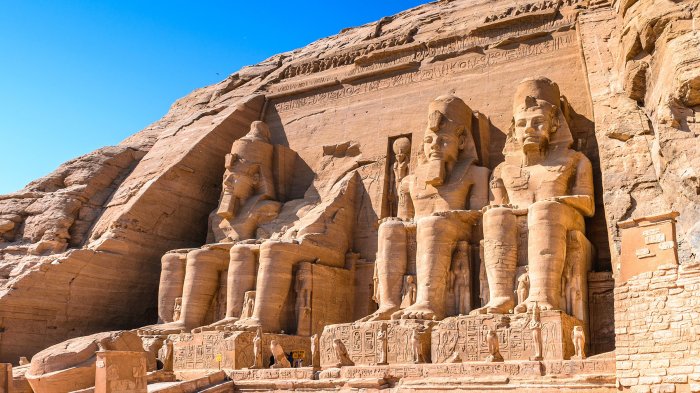
Abu Simbel stands out as a remarkable feat of ancient Egyptian architecture and holds immense historical and cultural significance. By comparing it to other prominent temples of its era, we can gain a deeper understanding of its unique characteristics and the broader context of Egyptian temple design.
Similarities among ancient Egyptian temples include their religious purpose as centers of worship and rituals dedicated to specific deities. They typically feature a series of courtyards, halls, and sanctuaries, each with a distinct function in the temple’s rituals. Additionally, the use of hieroglyphs and reliefs to narrate mythological stories and depict historical events is a common feature.
Abu Simbel, a UNESCO World Heritage Site, is a testament to ancient Egypt’s architectural prowess. As travelers seek out sustainable travel destinations , Abu Simbel offers a unique opportunity to immerse oneself in history while respecting the environment. Its temples, carved into sandstone cliffs, stand as a reminder of a time when humans lived in harmony with their surroundings.
Comparison with Karnak Temple Complex
Abu Simbel shares similarities with the vast Karnak Temple Complex in Luxor. Both complexes were constructed over extended periods, incorporating additions and modifications by successive pharaohs. However, Karnak’s sprawling layout and numerous temples dedicated to different deities contrast with Abu Simbel’s compact and unified design centered around the worship of Ramesses II.
Comparison with Hatshepsut’s Mortuary Temple
Another notable comparison is Hatshepsut’s Mortuary Temple at Deir el-Bahari. Both temples feature prominent rock-cut facades and incorporate natural rock formations into their design. However, Hatshepsut’s temple is distinguished by its terraced structure and extensive use of ramps and colonnades, while Abu Simbel’s facade is more monumental and symmetrical.
Historical Significance
Abu Simbel’s historical significance lies in its association with Ramesses II’s reign and his military victories. The temple’s colossal statues and reliefs commemorate his triumphs, particularly the Battle of Kadesh. In contrast, Karnak Temple Complex represents the religious and political power of the priesthood and the pharaohs throughout several dynasties.
Last Recap
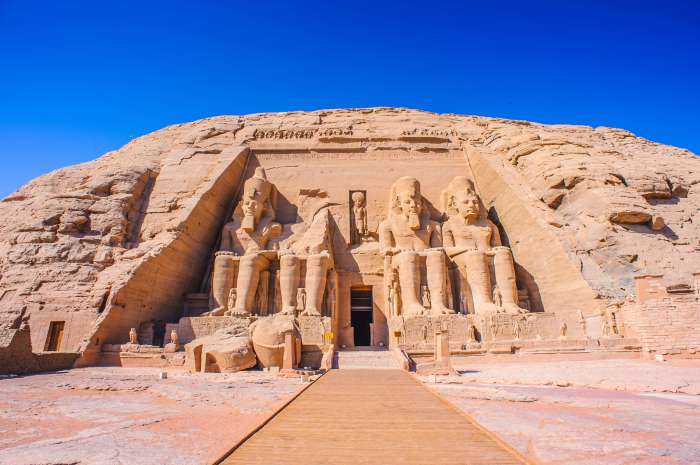
Abu Simbel continues to inspire awe and wonder in all who behold it. Its architectural brilliance, historical significance, and enduring cultural impact solidify its place as one of the most extraordinary wonders of the ancient world. A testament to human ingenuity and the enduring legacy of ancient Egypt, Abu Simbel stands as an eternal symbol of a civilization that reached unparalleled heights of achievement.
Helpful Answers
Where is Abu Simbel located?
Abu Simbel is located in southern Egypt, on the western bank of Lake Nasser.
When was Abu Simbel built?
Abu Simbel was built during the reign of Ramses II, around 1264 BC.
What is the significance of the colossal statues at Abu Simbel?
The colossal statues represent Ramses II and his family, and they symbolize his power and authority.